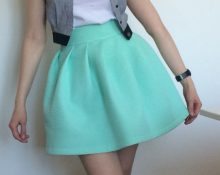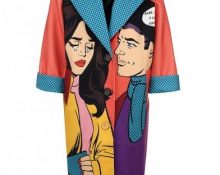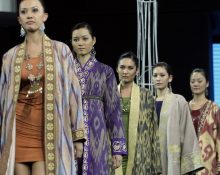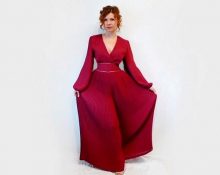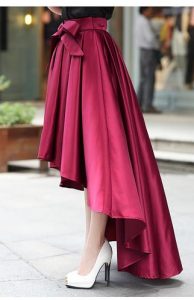
creativecommons.org
The skirt with a tail has many names, the most common being “mermaid skirt”. In this article we will tell you how to sew a skirt with a tail at the back and tell you where this unusual fashion came from. At the end of the material you will find recommendations for choosing fabric for this type of skirt, an exact pattern, as well as a visual diagram of sewing a skirt with a tail at the back.
The history of the skirt with a tail at the back
Despite the original look and claim to originality, skirts with a tail at the back have a rather long history. The prototype of the model of a skirt with a tail at the back was the skirt of the Rococo era, created especially for polonaise style dresses. The back of the skirt of fashionistas of the 18th century was significantly longer than the front and was additionally draped, creating additional volume. The fashion for polonaise skirts has passed, only to return in its new incarnation, a skirt with a bustle and a train, tailored in the 70s of the 19th century in France. It was during this period that the S-shaped silhouette came into fashion.The trendsetter of this fashion trend was the fashion designer and founder of the fashion house of the same name, Charles Frederick Worth, who, according to legend, came up with this silhouette while watching a maid who, sweeping the floor, she pulled part of her voluminous skirt back. Parisians sought to emphasize their shapes and the contrasting transition between a wasp waist and curvy hips, but since sophisticated French ladies for the most part did not have voluminous shapes, in order to keep up with fashion trends, they had to place bolsters (bustles) under the upper back part of the skirt and further lengthen back of the skirt for creating larger volume. For greater effect, the already thin waist was tightened with tight corsets. At the end of the 19th century, the back of the skirts lengthened and many dressmakers began to add lace to it. The fashion for skirts with bustles survived until the beginning of the twentieth century, transformed into the fashion for the so-called “fur-fur” (the name of the skirt, derived from onomatopoeia, conveying the rustle of expensive silk) and “mermaid skirts,” another subspecies of skirts with “ tails."
At the beginning of the twentieth century, the style of skirts with a tail at the back conquered Hollywood, the American capital of fashion, which by that time had taken this title from Paris. Due to the difficult political situation in Russia, this trend will come with a delay of almost 60 years, only in the 1980s. But in Europe, fashion was moving by leaps and bounds, and women, gaining more and more rights and freedoms, asked their dressmakers to shorten their skirts. During the rebellious 1930s, cascading skirt hems became even shorter and began to resemble modern mullets. This cut gave more freedom of movement and allowed ladies to dance the fashionable Charleston all night long.
Fashion for skirts with tails at the back today
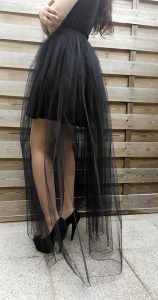
creativecommons.org
In general terms, the trends for skirts with tails at the back coincideYut with a pulsating trend towards an S-shaped silhouette. As soon as this shape appears on the covers of fashion magazines and on the figures of trendsetters, fashionistas confidently take skirts with tails at the back out of their closets. The style of these products, despite the formal appearance, is universal: a skirt with a tail at the back is suitable for daily wear and for an evening out. Office suits with midi skirts with a tail at the back emphasize the good figure of the owner of the set, and the right neutral color allows you to not go beyond even the strictest dress code. In a dress with a long skirt with a tail at the back, you can safely go to a social event or down the aisle. From season to season, only the sharpness of the difference between the front and back lengths of such skirts and the trendy colors of the skirts change: now it’s a classic mermaid skirt, now a skirt with a slight extension at the back and peplum, now a pleated mullet skirt, now a shocking mullet skirt. The names are different, but all of them can be formally classified as different subtypes of “skirts with a tail at the back.” Another advantage of a skirt with a tail at the back is that this style suits ladies with curvy figures, as well as on short girls. As with many timeless, versatile styles, a tail-back skirt has a different feel depending on the quality of the fabric and its density. Traditionally, thicker fabrics in dark and muted shades are more suitable for formal meetings and are popular with mature women, while lighter tulle materials are more suitable for young girls going to informal events.
What you need to sew skirts with a tail at the back
At this stage, the key issue is the choice of fabric for the skirt.Universal colors are muted and dark, but if the product is sewn for a specific event or image, then you can move away from the canon and allow yourself to shock the public with a choice of colors in the spirit of Balmain or Alexander McQueen.
- A piece of fabric. If you do not have much experience in tailoring, it is better to abandon the idea Withsew a “tail” from a different type of fabric and give preference to a plain version. This will reduce the time for cutting and sewing the product.
- Sewing supplies (needles, pins, threads, chalk for markings, scissors, measuring tape etc.).
- Pattern. Before starting work, it is better to spend enough time to adjust the pattern to your parameters or the parameters of the model.
- Having a sewing machine is optional, but using it will significantly speed up your work and improve its quality.
Step by step wizard–class on tailoring a skirt with a tail
First, you should re-create the pattern, focusing on the presented sample. To do this, you need to take measurements from the waist, hips, and also estimate on the model what the front and back length should be. Depending on the elasticity of the materialA you can add 2-3 centimeters to your waist or focus strictly on the parameters of the future owner of the skirt.
- Fold the fabric in half. Pay attention to the position of the shared thread.
- Using pins, secure the newly constructed pattern to the fold of the fabric.
- Mark the outline of the future skirt.
- Step back 1-2 cm from the edges and repeat the contour. This reserve will be needed to process the seams.
- Cut out the sample based on the previously indicated indentation.
- Sew the skirt together using a fitting stitch and try it on the model.
- If necessary, you can adjust the length and width of the product.
- Finish the bottom edge of the skirt and connect the two sides of the piece.


 0
0